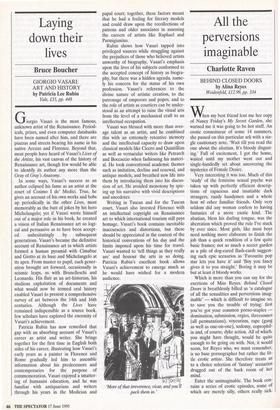Laying down their lives
Bruce Boucher
GIORGIO VASARI: ART AND HISTORY by Patricia Lee Rubin Yale, £35, pp. 448 Giorgio Vasari is the most famous, unknown artist of the Renaissance. Period- icals, prizes, and even computer databanks have been named after him, and there are piazzas and streets bearing his name in his native Arezzo and Florence. Beyond that, most people have heard of Vasari's Lives of the Artists, his vast canvas of the history of Renaissance art, though few would be able to identify its author any more than the Gray of Gray's Anatomy.
In some ways, Vasari's success as an author eclipsed his fame as an artist at the court of Cosimo I de' Medici. True, he gives an account of his own works and bobs up periodically in the other Lives, most memorably as the butt of jokes by his hero Michelangelo; yet if Vasari wrote himself out of a major role in his book, he created a vision of Italian Renaissance art so logi- cal and persuasive as to have been accept- ed unhesitatingly by subsequent generations. Vasari's became the definitive account of Renaissance art in which artists formed a human pyramid with Cimabue and Giotto at its base and Michelangelo at its apex. From master to pupil, each gener- ation brought art forward, occasionally in seismic leaps, as with Brunelleschi and Leonardo. His flair as an art-historian, his studious exploitation of documents and what would now be termed oral history enabled Vasari to present a comprehensive survey of art between the 14th and 16th centuries. Although the Lives have remained indispensible as a source book, few scholars have explored the enormity of Vasari's achievement.
Patricia Rubin has now remedied that gap with an absorbing account of Vasari's career as artist and writer. She brings together for the first time in English both sides of his career, illustrating how Vasari's early years as a painter in Florence and Rome gradually led him to assemble information about his predecessors and contemporaries for the purpose of commemoration. Vasari enjoyed a smatter- ing of humanist education, and he was familiar with antiquarians and writers through his years in the Medician and papal court; together, these factors meant that he had a feeling for literary models and could draw upon the recollections of patrons and older associates in assessing the careers of artists like Raphael and Parmigianino.
Rubin shows how Vasari tapped into privileged sources while struggling against the prejudices of those who believed artists unworthy of biography. Vasari's emphasis upon the lives of his subjects conformed to the accepted concept of history as biogra- phy, but there was a hidden agenda, name- ly his concern for the status of his own profession. Vasari's references to the divine nature of artistic creation, to the patronage of emperors and popes, and to the role of artists as courtiers can be under- stood as an attempt to raise the visual arts from the level of a mechanical craft to an intellectual occupation.
Vasari was blessed with more than aver- age talent as an artist, and he combined this with an extremely retentive memory and the intellectual capacity to draw upon classical models like Cicero and Quintillian as well as vernacular writers like Petrarch and Boccaccio when fashioning his materi- al. He took conventional academic themes such as imitation, decline and renewal, and antique models, and breathed new life into them by introducing them into his discus- sion of art. He avoided monotony by spic- ing up his narrative with vivid descriptions and anecdotes.
Writing in Tuscan and for the Tuscan court, Vasari also invested Florence with an intellectual copyright on Renaissance art to which international tourism still pays homage. Vasari's book contains inevitable inaccuracies and distortions, but these should be appreciated in the context of the historical conventions of his day and the limits imposed upon his time for travel. Vasari wanted to 'tell things as they really are' and honour the arts in so doing. Patricia Rubin's excellent book allows Vasari's achievement to emerge much as he would have wished for a modern audience.
More of that irreverence, vicar, and you' 1 pack them in.'


































































 Previous page
Previous page